"Nyt sain kuulla Jumalan sanua juur' kuin Jumalan suusta." Suomalaisen ortodoksisen ja kansallisen identiteetin rakentaminen pappismunkki ja piispa Kiprianin kritiikin avulla 1905–1914
Avainsanat:
Karjala, kansallinen identiteetti, Kiprian, Aamun Koitto, Karjalaisten Pakinoita, Laatokka-lehtiAbstrakti
The article shows how the ecclesiastical activities of the monk and later bishop of Sortavala, Kiprian (d. 1914), auxiliary to Sergiy, Orthodox archbishop of Vyborg and all Finland, aroused critical interpretations that contributed to the construction of Finnish-language Orthodoxy and Finnish nationalism. The sources analysed here are the Orthodox magazine Aamun Koitto (1896–1907), the mouthpiece of the Archangel Karelian national activists, Karjalaisten Pakinoita (1906–1909), and the newspaper published by the Sortavala-based Lutheran nationalists, Laatokka (1882–1914). In all these papers, the speakers represented the literate elite, mostly priests, schoolteachers, or journalists. Their writing thus tells more about the elite ideals than about grass-root nationalism. All three also occasionally quoted each other, thus creating an image of a ‘common front’.
As representative of the Finnish Orthodox diocese, Aamun Koitto’s main interest was religious. Because the Orthodox in Finland were a tiny majority (less than two percent of the population, divided into a Karelian majority and a Russian minority), the magazine strived to establish Orthodoxy as an ‘accepted’ religion in the predominantly Lutheran Finland. However, it fought only for the ‘Finnish’ Orthodox, ignoring Finland’s Russians. On the one hand, the magazine tried to convince its readers that Kiprian favoured Karelians and the construction of Finnish-language Orthodoxy. With this view, Aamun Koitto argued that the archbishop and his auxiliary supported the use of Finnish in liturgy, domestic mission, and other educational projects. When, around 1907, conservative elements were reinforced in Russia, Aamun Koitto stepped back but never fully dismissed the hierarchs. Rather, the magazine implied that they had (temporarily) taken a wrong course but would in the end return on the ‘right’ track.
Karjalaisten Pakinoita, representing the Archangel Karelian merchants and political activists, many of them living in Finland and supported by (Lutheran) Finnish nationalists, at first advocated the turning of Archangel Karelia (in Finnish, Viena) into a Finland-oriented territory. In the background was the notion that Russia was a backward country and that the development of Archangel Karelia was possible only in connection with Finland. Therefore, Karjalaisten Pakinoita tried to convince its readers of the necessity of Finnish schools and Finnish economical contacts. Kiprian, in turn, claimed that the success of the region depended on its close contacts with Orthodoxy and Russia as the guarantor of ‘true religion’. When he started to advocate Russian-language ecclesiastical schools (in place of the Finnish ‘profane’ schools), Karjalaisten Pakinoita dubbed him the enemy of all things Karelian, a ‘Russificator’ who threatened to impose a wrong national identity on the (Archangel) Karelians. Hence, most of what the magazine wrote of Kiprian, can be understood as attempts to make the Archangel Karelians accept the journal’s view that they were in fact ‘Finns’, not Russians or subjects of Russia, as Kiprian suggested. The same holds for Laatokka, which represented a more Finnish, and more Lutheran, view of nationalism. According to the newspaper, Karelians were Finns, because despite their ‘wrong’ religion, they (allegedly) spoke Finnish, not a Karelian language or dialect. Therefore, they belonged to the Finnish nation, and when Kiprian and Sergiy argued otherwise, they were ‘enemies of the people’. The magazine fiercely attacked Kiprian’s activities in founding ecclesiastical schools in Karelia, his plans to establish a convent in Karelia, and his efforts to educate Orthodox Karelian teachers in a Russian seminary (and not in Sortavala, where a teacher seminary was established in 1880 for Lutherans and Orthodox alike). Hence Laatokka represented an aggressive form of Finnish, Lutheran-tinged nationalism, which it also wanted to ‘plant’ in its readers by slandering Kiprian beyond any reasonable claims.



